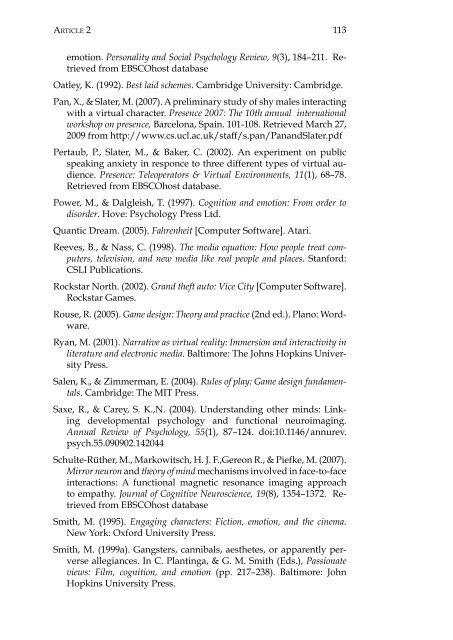Character Driven Game Design
Character Driven Game Design
Character Driven Game Design
Create successful ePaper yourself
Turn your PDF publications into a flip-book with our unique Google optimized e-Paper software.
Article 2 113<br />
emotion. Personality and Social Psychology Review, 9(3), 184–211. Retrieved<br />
from EBSCOhost database<br />
Oatley, K. (1992). Best laid schemes. Cambridge University: Cambridge.<br />
Pan, X., & Slater, M. (2007). A preliminary study of shy males interacting<br />
with a virtual character. Presence 2007: The 10th annual international<br />
workshop on presence, Barcelona, Spain. 101-108. Retrieved March 27,<br />
2009 from http://www.cs.ucl.ac.uk/staff/s.pan/PanandSlater.pdf<br />
Pertaub, P., Slater, M., & Baker, C. (2002). An experiment on public<br />
speaking anxiety in responce to three different types of virtual audience.<br />
Presence: Teleoperators & Virtual Environments, 11(1), 68–78.<br />
Retrieved from EBSCOhost database.<br />
Power, M., & Dalgleish, T. (1997). Cognition and emotion: From order to<br />
disorder. Hove: Psychology Press Ltd.<br />
Quantic Dream. (2005). Fahrenheit [Computer Software]. Atari.<br />
Reeves, B., & Nass, C. (1998). The media equation: How people treat computers,<br />
television, and new media like real people and places. Stanford:<br />
CSLI Publications.<br />
Rockstar North. (2002). Grand theft auto: Vice City [Computer Software].<br />
Rockstar <strong>Game</strong>s.<br />
Rouse, R. (2005). <strong>Game</strong> design: Theory and practice (2nd ed.). Plano: Wordware.<br />
Ryan, M. (2001). Narrative as virtual reality: Immersion and interactivity in<br />
literature and electronic media. Baltimore: The Johns Hopkins University<br />
Press.<br />
Salen, K., & Zimmerman, E. (2004). Rules of play: <strong>Game</strong> design fundamentals.<br />
Cambridge: The MIT Press.<br />
Saxe, R., & Carey, S. K.,N. (2004). Understanding other minds: Linking<br />
developmental psychology and functional neuroimaging.<br />
Annual Review of Psychology, 55(1), 87–124. doi:10.1146/annurev.<br />
psych.55.090902.142044<br />
Schulte-Rüther, M., Markowitsch, H. J. F.,Gereon R., & Piefke, M. (2007).<br />
Mirror neuron and theory of mind mechanisms involved in face-to-face<br />
interactions: A functional magnetic resonance imaging approach<br />
to empathy. Journal of Cognitive Neuroscience, 19(8), 1354–1372. Retrieved<br />
from EBSCOhost database<br />
Smith, M. (1995). Engaging characters: Fiction, emotion, and the cinema.<br />
New York: Oxford University Press.<br />
Smith, M. (1999a). Gangsters, cannibals, aesthetes, or apparently perverse<br />
allegiances. In C. Plantinga, & G. M. Smith (Eds.), Passionate<br />
views: Film, cognition, and emotion (pp. 217–238). Baltimore: John<br />
Hopkins University Press.
















